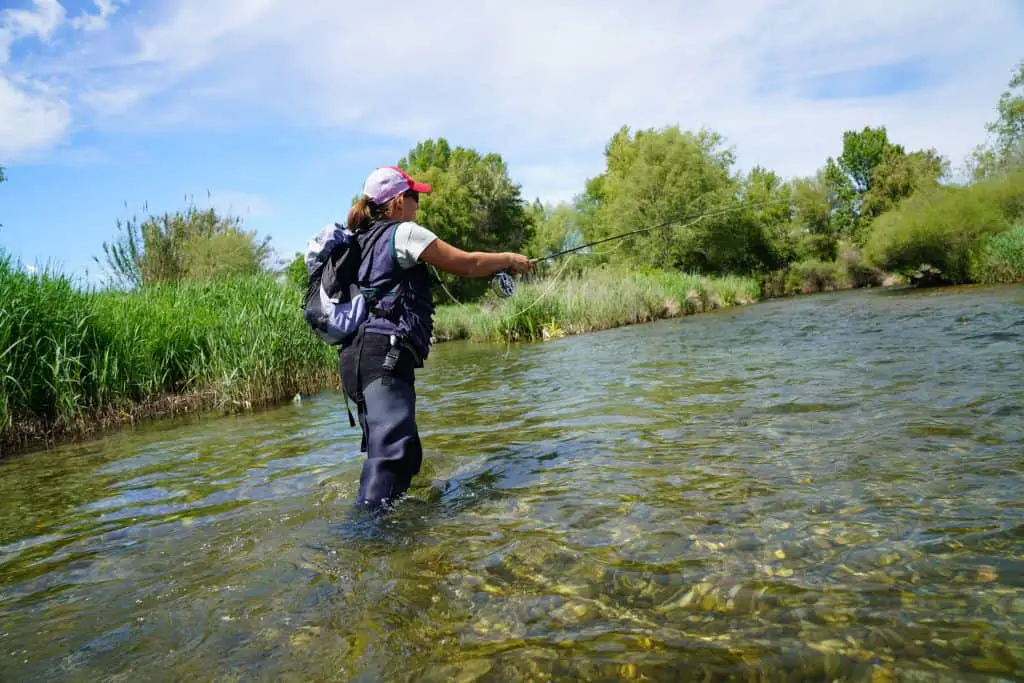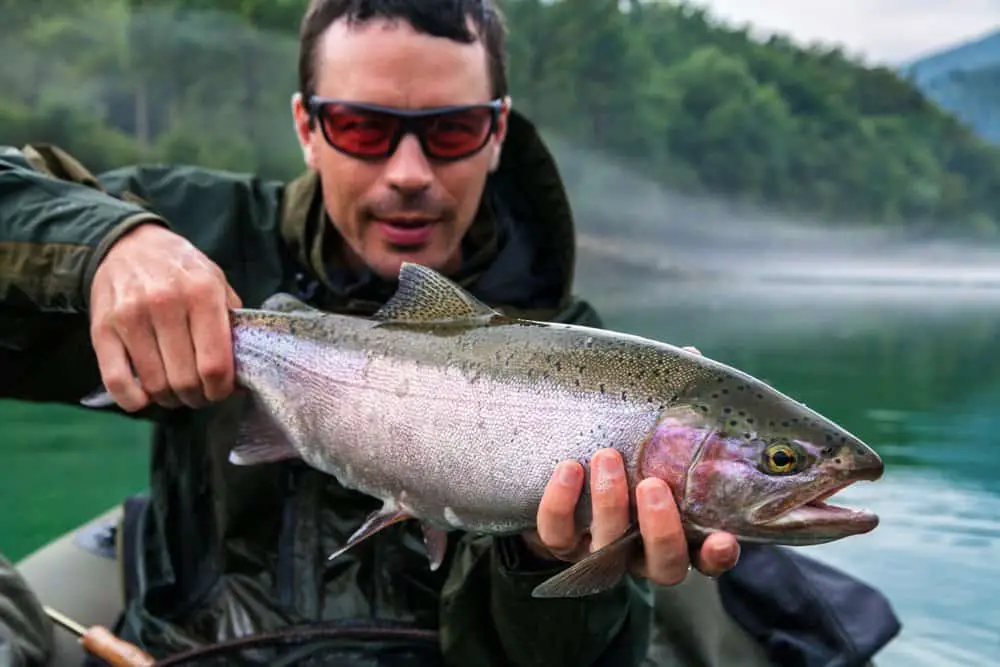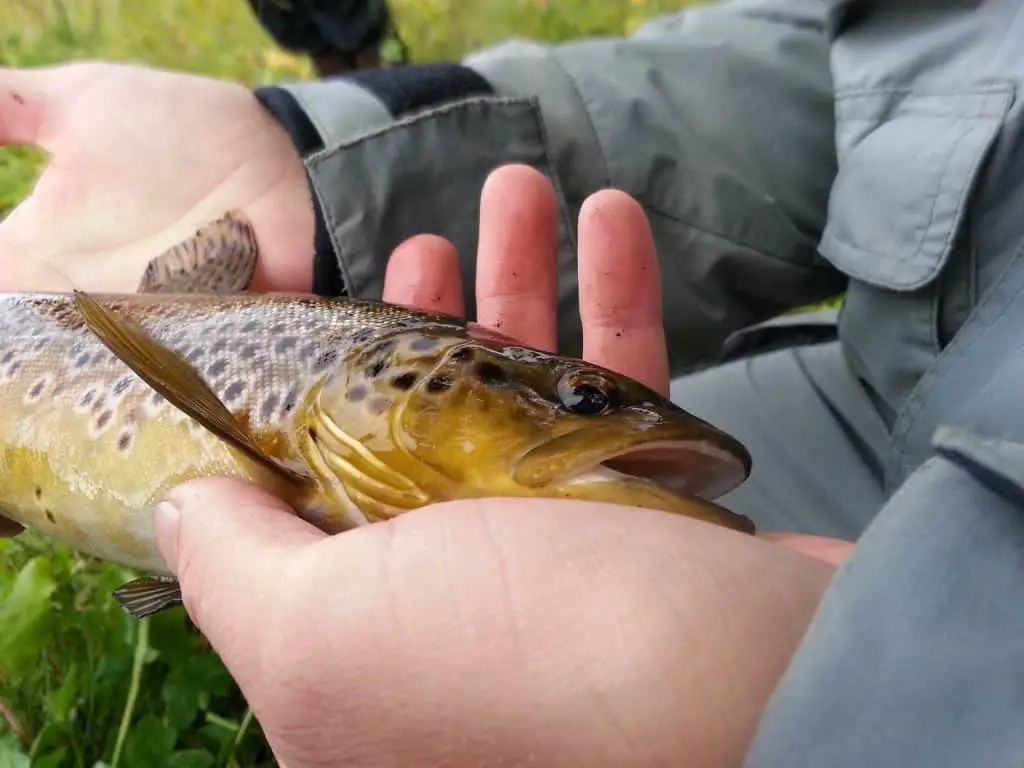As an Amazon Associate we earn from qualifying purchases.
Maybe you were lucky enough to recently be invited on a fly fishing trip with some of your friends. Or maybe, you’ve just always been intrigued by the sport. But to get started, you don’t need top shelf gear, and the cheapest fly fishing gear will do just fine to get you into the sport.
No matter the case, you’re looking at getting into the (life consuming) world of fly fishing, and you’re not sure what to do.
Getting started fly-fishing can be intimidating. Unlike fishing with traditional tackle, fly fishing is shrouded in mystery and tradition. Besides looking cool, the motivation to target fish with a fly rod is largely unexplainable. Beyond that, the equipment used for fly fishing may seem foreign to you.
And, like all things that interest me, fly fishing is a hobby that can get expensive fast. So, today we’re going to help you out. We’ve assembled a list of the cheapest fly fishing gear you can buy and use that will actually catch fish.
Unfortunately (for my wallet), I’m of the mindset that the most expensive, flashy, and beautiful tool is always the most effective.
But the truth is, the fish don’t give a crap about how much your rod cost, who designed your fly pattern, or how even the stitching is on your waders. This cheap fly-fishing gear will probably catch you just as many fish as a more expensive outfit.
We’ll start out with the fly fishing gear that is essential. If you’re going fly fishing, you’ll need this stuff. Then we’ll move onto more optional equipment. It may help you catch fish, or keep you warm while you do so, but you can catch fish without it.
If you’re just looking for a grocery list of what to buy, check these out:
| All-In-One | Orvis Encounter |
| Fly Rod | Reddington Classic |
| Fly Reel | Pflueger |
| Fly Line | Mainstream Fly |
| Leader and Tippet | Rio Powerflex |
| Waders | Simms Tributary |
| Wading Boots | Duck and Fish |
| Net | Sunrise Fishing |
But if you’re looking for more information, we’ve provided explanations for our recommendations below. Even if you’ve never fly fished in your life, you can probably guess the first item on our list:
Table of Contents
Fly Rod
Obviously, if you’re fly fishing, you’re going to need a fly fishing rod. There’s no way around it. But fly rods can cost upwards of a thousand dollars. Lucky for you, you don’t need to spend that kind of money.
You do need to ensure that the quality of the rod you’re buying is still worth the investment, though. Take my anecdotal experience into account: I grew up fly fishing at my lake house with a 50-year-old fly rod. It was ugly, showed visible signs of years of use, and was heavy. Casting the rod for hours left my shoulder throbbing the next day.
So, I went to Dick’s Sporting Goods and bought the cheapest rod and reel package they had. Eager to use my new prized possession, I headed to a local pond and fished for about 30 minutes before the rod snapped. Sure I saved some money buying a cheap setup, but a broken rod isn’t going to work, so I actually wasted money.
What I should have done instead is purchase a high quality affordable fly rod.
A rod that is reliable and effective, but still affordable. If I had done my research, I would’ve found two great options.
The Reddington Classic is an affordably priced, medium action fly rod especially designed for trout fishing. It comes in at 9 feet in length, breaks down into 6 pieces, and comes with a carrying case. The dark clay brown blank combined with the rosewood reel seat insert makes this rod look as pretty as many higher priced alternatives.
(click the photo below to check the price)

But, most importantly, this rod catches fish. I fished with a Reddington Classic on the Henry’s Fork in Idaho during a Salmonfly Hatch, and found I was able to cast large dry-flies and heavy nymph rigs accurately and effectively. My friends who work in fly fishing shops in Jackson, Wyoming say that this rod is the best starting rod on the market.
The best part of purchasing the Reddington Classic, though, is that it comes with a lifetime warranty. I have a strong tendency to break fly rods, so this feature is always highly valuable.
Another quality option is from Temple Fork Outfitters. TFO rod making company prides itself on crafting exquisite fishing instruments while avoiding the additional features that drive up costs. This particular model is available in multiple sizes that are all smooth and powerful, medium action rods. They come in a black matte finish with stylistic gold logos. The reel seats are anodized, and it comes with aluminum inserts.
This is actually the rod I recently convinced my dad to purchase while we were fishing the White River in Arkansas. He opted for the 9-foot 6 weight so that he could use it to throw streamers on the river, but also bass fish with it when we got home. I’ve found the rod to cast well, and I’ve enjoyed borrowing this rod to fish with it on several occasions.
During a mayfly hatch on Lake Guntersville, I used this Temple Fork Outfitters six weight to catch a two pound catfish on a hopper fly.
(In fact, it was with this rod that I made one of my strangest catches: During a mayfly hatch on Lake Guntersville, I used this Temple Fork Outfitters six weight to catch a two pound catfish on a hopper fly.)
If you’re looking for an all-in-one package, you’re in luck. Orvis’ Encounter combo costs under $200 usually and includes a reliable rod, reel, and fly line. Having cast this rod on numerous occasions, I can say that it gets the job done. It’s not as sensitive of other rods, which means you may miss some subtle hits. It also won’t cast as accurately or as far as more expensive rods. You will be able to catch fish with it, though, and it will last you for years.
If you choose to go with the Encounter package, these next two items on the list won’t be of need to you.
Fly Reel
After purchasing a cheap, but reliable fly rod, the next thing you’ll need is a reel. The quality of reel you will need will depend upon what you’re fishing for. Most fishermen targeting trout or bass won’t need a high quality reel because the fish they’re catching wont be pulling significant amounts of drag. However, people fishing for steelhead, saltwater fish, or any other powerful species will need a reliable drag system in their reel. These reels will be more expensive.
If you’re just fishing for small fish that won’t be ripping drag, I encourage you to save a ton of money and buy something cheap, like this reel from Pflueger. This thing won’t last forever, and is definitely not a high-quality piece of fishing equipment, but all you need it for is holding your fly-line, and reeling that fly line in. It will get that job done.
In fact, that brings me to another story, I was recently on vacation in Belize with my family, and decided not to bring my fly fishing gear, as my dad and I had booked a guide for 5 days. When we got to our resort, though, I saw schools of bonefish just off our beach. Irate with myself, I went to the local hardware store and purchased that exact Pflueger fly reel, an equally crappy fly rod, and something that looked like fly line.
I spent the rest of the trip fishing with that set up, and managed to use it to catch several bonefish, including the one below. While I don’t recommend this reel for this type of fishing, I believe its performance in these situations proves its worth.
If you’re fishing for redfish, steelhead, salmon, or any other hard-fighting, large fish, I highly recommend that you purchase a reel that has a drag system that will handle this task. Unfortunately, this is going to cost you quite a bit more than the Pflueger.
My recommendation is that you purchase the Reddington Behemoth.
(click the photo below to check the price)

These reels come in a variety of sizes and are a favorite among guides for their reliability, durability, and consistency. It is the best reel for the cost, in my opinion, as it functions as a high performance reel at a fraction of the cost.
One of my favorite guides in the country has used these reels for years fishing for the monster trout of the White River in Arkansas. On my first trip to this river, this is the exact reel that I used to land the 22-inch brown trout pictured below. That fish was caught on the last cast of the day, throwing a hopper. The image of this fish hitting my fly will never leave my mind.
Fly Line
Now that you have your rod and reel, you’re one purchase away from everything that you need in your first fly fishing setup. This next purchase is your fly line.
The fly-line is what allows you to cast, and is therefore an extremely important piece of your equipment. Using bad quality fly line will keep you from casting accurately or with distance, can spook fish, and will cost you more money in time as the line quickly wears out.
Now, the type of fly line you’ll need is highly dependent on the type of fishing you’re doing. The lines have different weights, some sink while others float, and some are longer than others.
No matter the case, the folks over at Rio have you covered with their Mainstream Fly Line series:
(click the image below to check the latest price)

These lines are the cheapest model from the storied line making company, but are tailored for novice and intermediate fly fishermen. The shorter head length and heavier overall weight allows adequate performance from sub-par casting technique. The Mainstream Lines come in multiple different models, so there’s sure to be one to suit your needs.
While you’re purchasing your fly line, you’ll also need to purchase leader and tippet. On a fly fishing set up, the fly is connected to the tippet, the tippet is connected to the leader, and the leader is connected to the fly line.
Because the tippet and the leader are so close to the fly, I encourage you not to avoid cutting costs in these purchases. For tippet and leader, I recommend using Rio’s Powerflex series:
(Click the image below to check the price)

Waders
Now, depending on where and when you’re fishing, waders may not be necessary. Even if you’re fishing for trout in ice-cold water, you can still get away with not wearing waders. Some people (myself included) even prefer going wader-less, especially on a hot day.
But if you’re fishing for trout in the late fall, winter, or early spring, you may have to wear waders to safely fish.
Waders can be extremely expensive though, so if you decide you need waders, you’re going to have to look hard to save money. Buying the cheapest waders you can find, though, is a bad idea. The cheapest waders will work a few times, but once they get ripped or hole poked enough, they’ll be useless.
That’s why I encourage you to spend a little extra money and buy the Tributary Waders from Simms:
(Click the image to check the latest price)

While not really the cheapest fly fishing gear you can find, they are the most affordable model from arguably the most trusted and proven brand.
Where you can really save money, though, is when buying wading boots. Because the waders themselves are watertight, the boots aren’t nearly as important. That’s why, if you’re trying to save money, I recommend buying these cheap boots from Duck and Fish. They aren’t the highest quality, but they’ll get the job done.
Net
The last piece of equipment we’ll talk about is a net. Again, depending on the type of fishing that you’re doing, a net may or may not be necessary.
I will say, though, that in my experience trout fishing, I land more fish while using a net. This is because a net allows you to quickly and safely subdue a fish before removing the hook. If you’re fishing alone, a net will also allow you to more easily photograph the fish, and if you don’t take a picture of your fish, did you really even catch it?
That being said, if you’re fly-fishing for trout or salmon, you can’t just run down to Walmart and buy the first net you see. But if you’re fishing for bass or other similar species, that’s exactly what I recommend you do.
Trout and Salmon aren’t like other fish. Instead of being covered in scales, their flesh has a protective antimicrobial slime all over it. This slim is imperative for the fish’s immune system and removing it can threaten the fish’s survival.
Therefore, when practicing catch and release fishing of trout or salmon, you need to purchase a net that won’t remove this slime. These nets typically are made of nylon or rubber, and these substances leave the fish unharmed.
A perfect and affordable option is this net from Sunrise Fishing:
(Click the image below to check the price)

Cheapest Fly Fishing Gear – Conclusion
So, there you have it! If you use our guide, you’ll have everything you need to get started fly fishing, and you’ll have saved a bunch of money on the way.
Now, of course, there are plenty of other things that you may realize you want down the line such as fly boxes, packs, polarized sunglasses, waterproof gloves, or even a boat. But you can buy all that stuff later. For now, just focus on the necessities, and get out there and fish!
If you’re just getting started fly fishing and you’re on a budget, let us know what products you used! We hope we helped you in your search for the cheapest fly fishing gear!
If you found this article to contain helpful information to help you purchase high quality, cheap fly fishing gear, make sure to give us a like and share it with your fishing buddies.
Amazon and the Amazon logo are trademarks of Amazon.com, Inc, or its affiliates.




Excellent value driven article here. Tons of information. Appreciate it.
Thanks Brian. Have a great day.